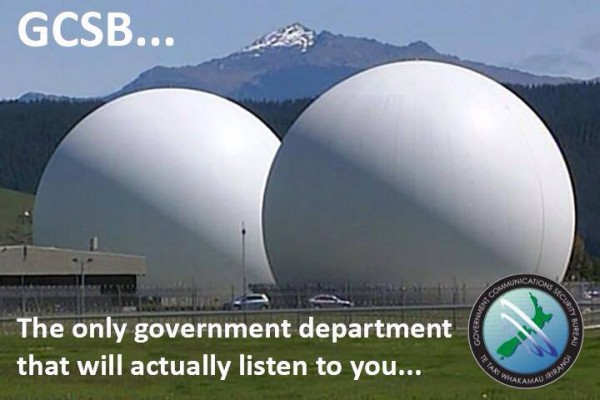Technological advances may mean the Waihopai spy station is becoming an ever greater threat to people’s privacy.
The Waihopai facility was built to intercept phone calls passing through commercial communications satellites over the Pacific and pass that information on to the US National Security Agency and other members of the Five Eyes electronic spying network.
We know that Government Communications Security Bureau can easily record the “metadata” of those calls – such as who called who and when – but there have been computer capacity limits on how much of the actual content of the phone calls can be stored.
Now the NSA has now progressed the Five Eyes technology to the point where it is “capable of recording ‘100 percent’ of a foreign country’s telephone calls, enabling the agency to rewind and review conversations as long as a month after they take place,” according to the Washington Post (March 19).
The Post used the Snowden files to reveal that the NSA has brought into operation two programmes, a voice interception programme called MYSTIC and a “retrospective retrieval” tool called RETRO – which retrieves “audio of interest that was not tasked at the time of the original calls…. Each month, [NSA analyists] send millions of voice clippings, or ‘cuts’, for processing and long-term storage.”
The MYSTIC and RETRO systems were to be fully operation by 2011, initially to swallow one particular “nation’s telephone network whole”, and then to take in five other countries. The NSA’s earlier storage constraints have been overcome by new “cloud-based collection systems and a gargantuan new ‘mission data depository’ in Utah.”
This means a lot more people (including New Zealanders) will have their phone calls analysed and their “voice clippings” stored by the NSA. As we know, detecting criminality is only a minor part of the NSA’s function. The agency is mainly dedicated to spying on foreign governments and individuals with the aim of countering those who are assessed as challenging those US political or economic interests – for example, critics of the Trans-Pacific Partnership. So TPPA protesters in New Zealand can expect to have more of their international phone calls to like-minded people overseas identified and analysed by the NSA. New voice recognition and voice-to-text technology will also make this easier for the NSA.
The GCSB, through its Waihopai spy station, helps the NSA’s MYSTIC and RETRO programmes by passing on to the NSA all the phone calls it intercepts. In the light of the greater threats to privacy posed by the MYSTIC and RETRO systems we need to ask more questions about the involvement of the GCSB.







Ok … thanks for the reminder, tho many of us already knew that. The big question is if it is realistically possible to stop or even only control this surveillance industry Moloch? (A Moloch usually gets bigger, not smaller, and technology will literally open many new doors).
Most people don’t seem to care, that’s the sad bottom line. And surveillance and ‘security’ is now a not insignificant part of the world economy. As far as data and privacy protection goes we have lost the plot some time ago. All an individual is left to do now is to cross fingers that he or she won’t be adversely affected either by the above surveillance or identity theft. And that’s exactly what most are doing. And at this point 1933 springs to mind, when many Germans started to cross fingers.
It’s a pretty depressing situation.
The caption on the graphic above sums it up perfectly. It seems sadly ironic to me that the immensely powerful possibilities opened up by digital technology are being used to spy on citizens, rather than engage them. I don’t really support Binding Referenda, but not because I disagree that governments need to be more accountable once elected, but because I think we have the means to do much better than expensive, one-off voting exercises.
With even a fraction of the technology budgets given to the GCSB, SIS, police spy units etc democracy could be brought into the 21st century, actively involving citizens and their knowledge and ideas in the day-to-day running of government and public services, using free code tools like Loomio:
http://www.shareable.net/blog/loomio-the-occupy-inspired-app-for-consensus-decision-making
Comments are closed.